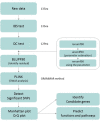Genome-wide association studies on collagen contents trait for meat quality in Hanwoo
- PMID: 37093907
- PMCID: PMC10119448
- DOI: 10.5187/jast.2022.e110
Genome-wide association studies on collagen contents trait for meat quality in Hanwoo
Abstract
Beef consumers valued meat quality traits such as texture, tenderness, juiciness, flavor, and meat color that determining consumers' purchasing decision. Most research on meat quality has focused on marbling, a key characteristic related to meat eating quality. However, other important traits such as meat texture, tenderness, and color have not much studied in cattle. Among these traits, meat tenderness and texture of cattle are among the most important factors affecting quality evaluation of consumers. Collagen is the main component of connective tissues.It greatly affects meat tenderness. The objective of this study was to determine significant variants and candidate genes associated with collagen contents trait (total collagen) through genome-wide association studies (GWAS). Phenotypic and genomic data from 135 Hanwoo were used. The BLUPF90 family program and GRAMMAR method for GWAS were applied in this study. A total of 73 potential single nucleotide polymorphisms (SNPs) showed significant associations with collagen content. They were located in or near 108 candidate genes. TMEM135 and ME3 genes were identified to have the most significant SNPs associated with collagen contents trait. Data indicated that these genes were related to collagen. Biological processes and pathways for the prediction of biological functions of candidate genes were confirmed. We found that candidate genes were involved in positive regulation of CREB transcription factor activity and actin cytoskeleton related to tenderness and texture of beef. Three genes (CRTC3, MYO1C and MYLK4) belonging to these biological functions were related to tenderness. These results provide a basis for improving genomic characteristics of Hanwoo for the production of tender beef. Furthermore, they could be used they could be used as an index to select desired traits for consumers.
Keywords: Collagen; Genome-wide association studies (GWAS); Hanwoo; Meat quality; Single nucleotide polymorphisms (SNPs); Tenderness.
© Copyright 2023 Korean Society of Animal Science and Technology.
Conflict of interest statement
No potential conflict of interest relevant to this article was reported.
Figures




Similar articles
-
Genome-Wide Association Study of Meat Quality Traits in Hanwoo Beef Cattle Using Imputed Whole-Genome Sequence Data.Front Genet. 2019 Nov 29;10:1235. doi: 10.3389/fgene.2019.01235. eCollection 2019. Front Genet. 2019. PMID: 31850078 Free PMC article.
-
Multi-breed and multi-trait co-association analysis of meat tenderness and other meat quality traits in three French beef cattle breeds.Genet Sel Evol. 2016 Apr 23;48:37. doi: 10.1186/s12711-016-0216-y. Genet Sel Evol. 2016. PMID: 27107817 Free PMC article.
-
Investigation of high correlation with carcass traits of SNPs of the PLCB1, C/EBPα, and TDRKH genes and the combinations of SNPs using the MDR method in the Hanwoo.Genes Genomics. 2021 Aug;43(8):961-973. doi: 10.1007/s13258-021-01122-y. Epub 2021 Jun 15. Genes Genomics. 2021. PMID: 34129193
-
Exploring and Identifying Candidate Genes and Genomic Regions Related to Economically Important Traits in Hanwoo Cattle.Curr Issues Mol Biol. 2022 Dec 4;44(12):6075-6092. doi: 10.3390/cimb44120414. Curr Issues Mol Biol. 2022. PMID: 36547075 Free PMC article. Review.
-
Contribution of intramuscular connective tissue and its structural components on meat tenderness-revisited: a review.Crit Rev Food Sci Nutr. 2024;64(25):9280-9310. doi: 10.1080/10408398.2023.2211671. Epub 2023 May 17. Crit Rev Food Sci Nutr. 2024. PMID: 37194652 Review.
Cited by
-
An overview of recent technological developments in bovine genomics.Vet Anim Sci. 2024 Jul 23;25:100382. doi: 10.1016/j.vas.2024.100382. eCollection 2024 Sep. Vet Anim Sci. 2024. PMID: 39166173 Free PMC article. Review.
-
Study on the current research trends and future agenda in animal products: an Asian perspective.J Anim Sci Technol. 2023 Nov;65(6):1124-1150. doi: 10.5187/jast.2023.e121. Epub 2023 Nov 30. J Anim Sci Technol. 2023. PMID: 38616880 Free PMC article. Review.
-
Genetic parameters and genome-wide association studies including the X chromosome for various reproduction and semen quality traits in Nellore cattle.BMC Genomics. 2025 Jan 10;26(1):26. doi: 10.1186/s12864-024-11193-2. BMC Genomics. 2025. PMID: 39794685 Free PMC article.
-
Analyzing Runs of Homozygosity Reveals Patterns of Selection in German Brown Cattle.Genes (Basel). 2024 Aug 9;15(8):1051. doi: 10.3390/genes15081051. Genes (Basel). 2024. PMID: 39202411 Free PMC article.
-
Scans for Signatures of Selection in Genomes of Wagyu and Buryat Cattle Breeds Reveal Candidate Genes and Genetic Variants for Adaptive Phenotypes and Production Traits.Animals (Basel). 2024 Jul 13;14(14):2059. doi: 10.3390/ani14142059. Animals (Basel). 2024. PMID: 39061521 Free PMC article.
References
-
- Bulik-Sullivan BK, Loh PR, Finucane HK, Ripke S, Yang J. Schizophrenia Working Group of the Psychiatric Genomics Consortium, et al. LD score regression distinguishes confounding from polygenicity in genome-wide association studies. Nat Genet. 2015;47:291–5. doi: 10.1038/ng.3211. - DOI - PMC - PubMed
LinkOut - more resources
Full Text Sources
Miscellaneous

